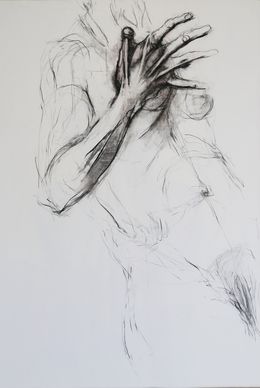
Autoportrait
Cécile Beaupère
Fine Art Drawings - 91.5 x 62.5 x 0.2 cm Fine Art Drawings - 36 x 24.6 x 0.1 inch
$1,665
From the beginning of Cécile Beaupère's artistic journey, the body was required. It was essential, unavoidable. Not only the body as an object of representation, but also as an actor. The interest that Cécile Beaupère had in posing for others questioned her and led her as an artist to merge two postures: being the artist and the model at the same time. All in one!
In this case we could speak of a self-portrait. But the name Autonu is more appropriate, because Cécile Beaupère's attention is focused more on her anatomy than on her identity. Through this series that she has been practicing for many years, a real working method has been put in place: while adopting poses of varying durations, she draws herself, either with the help of the mirror or without. In the first case, the point of view is more distanced, moving towards the image that the reflection offers. In the second case, it slides along the body and heads it.
She combined these Autonus at all tempos, diversifying the mediums and formats. Exposure times can range from a few seconds to extended periods. Thus, when the artist takes the time to observe and draw, it is the model who tenses and tires to hold the pose, ... while drawing. And if the fixed duration is short, it is the artist who enters into tension, having to sketch against the clock. In short, a real fight between oneself and oneself. A form of double bind, of psycho-physical dissociation which involves challenge and performance.
In the artistic tradition, the nude self-portrait has been more rarely treated by painters than the self-portrait, undoubtedly out of modesty and/or the lack of individual characterization offered by the image of the body. We know well those of Dürer, of Schiele, a little less those of Paula Modersohn, or Alice Neel, which were made using a mirror. In her paintings of nude self-portraits, the American artist Joan Semmel did without it by using the camera. There we find, as with Cécile Beaupère, the shifts in space, the amplification of the bodily areas closest to the gaze, characteristics of the self-portrait without reflection. On the other hand, Cécile's working process differs, in that her direct practice of drawing takes place without any mediation, in the dazzlingness of an instant, drawing-posing.
As for the artist's animal self-portraits, they do not stem so much from an interest in fable or fantasy; they are there as if by break-in. Figures who took advantage of a commission made to the artist to establish themselves. Disarray, letting go, who knows, a reassessment of oneself, brought these beings from the depths. A resurgence, but a resurgence of what?
These fantastical doublings may have escaped from a family line. Cécile Beaupère indeed belongs to a line of women painters, who from grandmother, to mother, then to daughter, passed the artistic torch. Her grandmother Germaine Théoleyre was an animal painter. However, it turns out that far from the workshop, Cécile likes to draw the animals she observes in the landscape. How did these actors, until then kept behind the scenes, enter into performance? The series begins with trembling ape faces adjusting themselves to a female chest, staring at us. Little by little, the strangeness of these monkey heads - although similar to human features - gives way to the more assertive mouths of the dog and the horse. The monotypes tighten their frame around these faces which come to life, leave us with our gaze, live their lives, consider themselves and express themselves, to the point of shouting out in a spectral light, their bewilderment and their distress.
Danièle GUTMANN

Fine Art Drawings - 91.5 x 62.5 x 0.2 cm Fine Art Drawings - 36 x 24.6 x 0.1 inch
$1,665
What are their 3 main works?
When was Cécile Beaupère born?